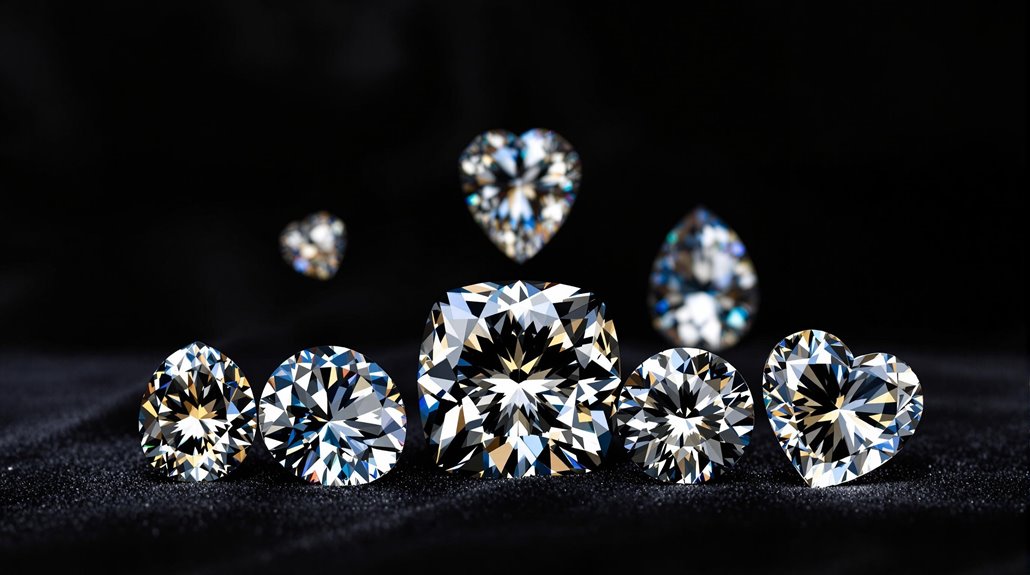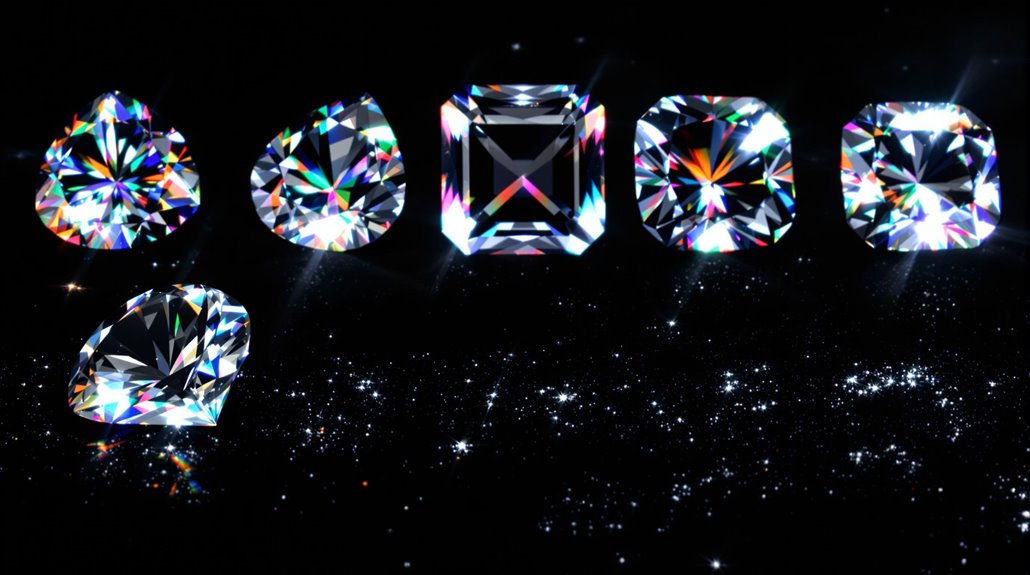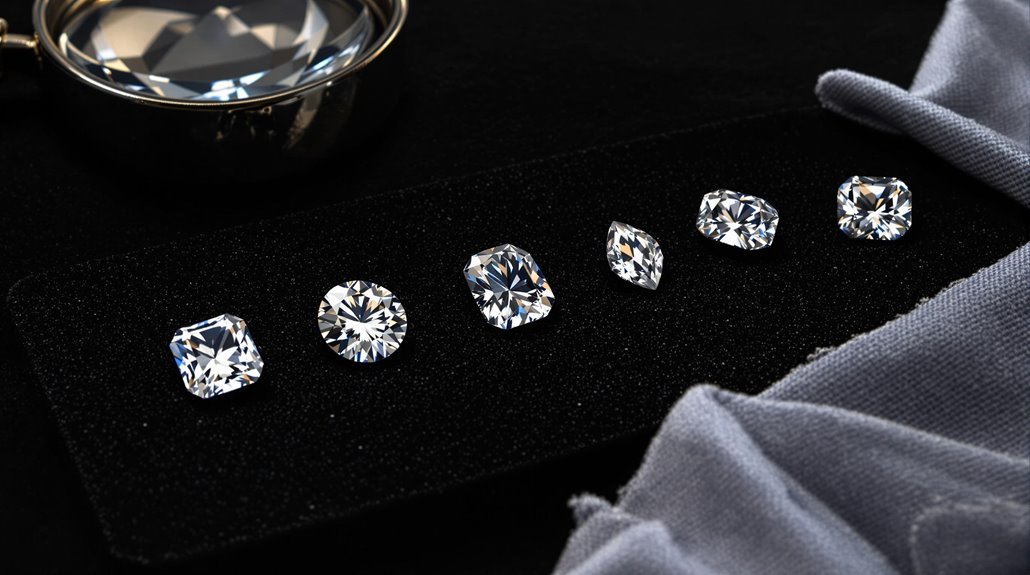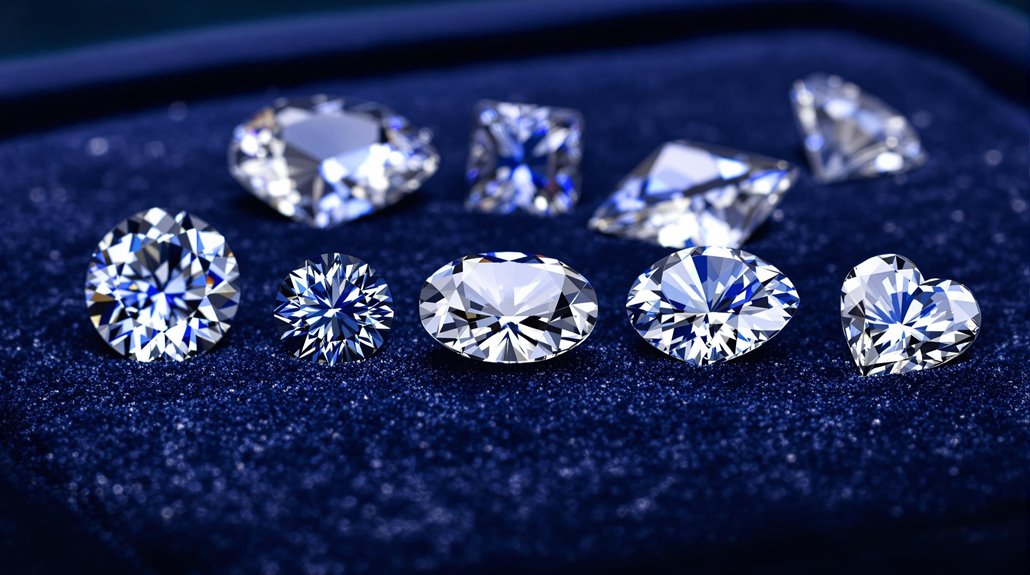Article Contents
- 1 Main Highlights
- 2 The Magic of Diamond Shapes
- 3 Understanding Diamond Cut Vs Shape
- 4 Popular Fancy Diamond Shapes
- 5 Choosing Based on Hand Type
- 6 Maximising Sparkle and Brilliance
- 7 Budget-Smart Diamond Shape Selection
- 8 Care Tips For Different Shapes
- 9 Frequently Asked Questions
- 9.1 Can diamond shapes affect how durable the stone is over time?
- 9.2 Do Certain Diamond Shapes Require More Frequent Professional Cleaning Than Others?
- 9.3 How Does Diamond Shape Influence the Appearance of Inclusions?
- 9.4 Which diamond shapes are most likely to trap dirt underneath?
- 9.5 Do some diamond shapes appear more yellow when set in different metals?
- 10 Our Final Thoughts
While round brilliants captivate with their classic charm, your perfect diamond match might sparkle in an unexpected shape. Your hand's unique characteristics can guide you toward shapes that enhance its natural grace – from elegant ovals that elongate shorter fingers to bold marquise cuts that complement larger hands. Consider how each shape's distinct personality meshes with your style: princess cuts speak of modern sophistication, cushion cuts whisper romance, and pear shapes merge timeless elegance with contemporary flair. Each cut's interaction with light creates its own enchanting movement, and understanding these subtleties will illuminate your path to the perfect choice.
Main Highlights
- Princess cuts offer modern sophistication with 58-76 facets, making them an excellent alternative to round brilliants for engagement rings.
- Oval diamonds create an illusion of a larger size compared to round diamonds and provide an elongating effect on fingers.
- Hand size and finger length should guide shape selection, with small hands suiting delicate princess cuts and long fingers matching ovals.
- Cushion cuts blend vintage charm with modern brilliance, incorporating light-maximising techniques similar to round brilliants.
- Pear-shaped diamonds combine round and marquise elements, creating an elegant teardrop silhouette that maximises perceived size.
The Magic of Diamond Shapes
Ten distinct diamond shapes captivate jewellery enthusiasts worldwide, each offering its own unique charm and brilliance. As you investigate diamond shape trends, you'll discover how each cut transforms light into a mesmerising performance of sparkle and fire. The step cut diamonds provide more subtle light reflections compared to brilliant cuts.
Sustainable engagement rings are increasingly popular among conscious consumers in 2024. From the classic round brilliant's perfect symmetry to the romantic soul of cushion cuts, your perfect match awaits. Round brilliants lead the market as the most sought-after diamond shape due to their superior sparkle.
Today's unique diamond styles reflect your desire for self-expression. You'll find the elongated grace of oval and pear shapes that make fingers appear more slender, or the bold geometry of princess cuts that command attention.
Whether you're drawn to the traditional sparkle of brilliant cuts or the sophisticated clarity of step cuts, your choice tells a story. Each diamond shape carries its own personality, waiting to align with yours in a harmonious expression of style.
Understanding Diamond Cut Vs Shape
During a discussion about diamonds, you might hear "cut" and "shape" used interchangeably, but these are distinct qualities that come together to create a stone's enchanting allure.
A diamond's cut refers to its internal architecture – those precise angles and facets that direct light through the crystal in a beautifully orchestrated display. With three primary categories of diamond cuts available, each offers unique faceting patterns.
Its shape, whether a classic round brilliant or a romantic heart, sets the stage for this light performance to unfold, with each silhouette providing its own unique symphony of sparkle and fire. The interplay of these elements is crucial, as even the most beautiful shape requires excellent cut quality to achieve maximum brilliance.
Cut Basics vs. Shape
Although many people use the terms "cut" and "shape" interchangeably when discussing diamonds, they are actually two distinct characteristics that impact a stone's appearance in different ways.
When you're searching for your perfect diamond, think of cut quality as the soul of the stone – it's what brings your diamond to life through its interaction with light, creating that mesmerising performance of brilliance and fire.
Your shape preference, conversely, is like choosing the diamond's silhouette, whether it's the classic round brilliant or one of the stunning elaborate shapes that speak to your unique style. A step cut diamond like the emerald shape emphasises clarity with its large open facets.
Comprehending this distinction empowers you to make choices that align with both your desire for sparkle and your personal aesthetic, leading you to a diamond that truly resonates with your spirit. The symmetry and proportions of a diamond's cut are crucial elements that determine how effectively it reflects light back to the viewer's eye.
Light Play By Type
Understanding how light travels through different diamond cuts highlights the essential differences between cut styles and their impact on a stone's sparkle.
The brilliant cut's facet arrangement creates a captivating performance of light, where triangular and kite-shaped patterns release a symphony of fire and brilliance you'll find irresistible.
Conversely, step cuts, with their parallel facets, offer you a different kind of magic – a sophisticated hall of mirrors effect that appeals to those who appreciate clean lines and architectural beauty.
The stunning round brilliant cut remains the most sought-after shape for its superior sparkle and fire.
You'll find that light dispersion varies significantly between these styles.
Expert cutters craft these stones with 58 precise facets to maximise their sparkle and brilliance.
While brilliant cuts celebrate dynamic light play with maximum sparkle, step cuts showcase clarity with elegant restraint.
Your choice ultimately reflects your personality: do you crave the striking fireworks of a brilliant cut, or the refined elegance of step-cut harmony?
A common misconception in diamond shopping blurs the line between a diamond's cut and its shape. As you delve into the mesmerising world of diamonds, you'll discover that different shapes often share similar cut patterns, creating a fascinating interplay of light and geometry. The facets' interaction with light determines how brilliantly each diamond sparkles, regardless of its shape.
This shapes versatility means you're not constrained by traditional expectations. Brilliant cuts represent about 75% of all diamonds sold today.
When you probe deeper, you'll notice that many elaborate shapes incorporate elements of the brilliant cut, demonstrating remarkable cut similarities across various forms.
A cushion-cut diamond, for instance, borrows the same light-maximising principles found in round brilliants. You'll find that whether you're drawn to the classic round or the distinctive pear shape, the underlying cut patterns work in harmony to create that captivating sparkle you're pursuing.
Popular Fancy Diamond Shapes

When you're searching for your perfect diamond shape, you'll discover how the graceful teardrop silhouette of a pear-shaped diamond creates an enchanting performance of light whilst elongating your finger. For optimal visual appeal, the pear shape should maintain a length-to-width ratio of 1.5 to 1.7.
The oval's sophisticated curves work magic on shorter fingers, offering a flattering effect that's both timeless and mesmerising. The hall-of-mirrors effect makes emerald cut diamonds particularly captivating when viewing their interior depths.
If you're drawn to contemporary aesthetics, the clean lines and brilliant sparkle of the princess cut bring modern sophistication to your ring, creating a stunning statement that reflects your forward-thinking style.
Pear's Elegant Teardrop Design
Known for its distinctive mixture of round and marquise cuts, the pear-shaped diamond creates an elegant teardrop silhouette that has captivated jewellery lovers since its creation in 1458.
You'll find its graceful form enhances your finger's natural length, as its 58 facets twirl with light in a mesmerising display of teardrop elegance. Pear-shaped diamonds often cost less than round cuts, making them a budget-friendly choice.
The pear's versatility shines through its adaptable proportions, with ideal length-to-width ratios between 1.55 and 1.75 offering the most balanced appearance. For optimal aesthetics, the tapered point faces downward when worn on the finger.
You're not just choosing a diamond – you're accepting a piece of artistic heritage that works beautifully in both vintage and modern settings.
Whether you prefer a slim, elongated silhouette or a fuller, more striking presence, this unique shape lets you express your individual style whilst maintaining sophisticated charm.
Oval's Flattering Finger Effect
The oval diamond's elongated brilliance creates an enchanting illusion that makes fingers appear longer and more slender. If you're pursuing a diamond that captures both timeless elegance and contemporary charm, you'll find the oval's versatility truly liberating.
The shape's slenderising illusion makes it especially flattering on wider fingers. Its unique shape offers remarkable finger elongation effects as it maximises the appearance of carat weight, giving you more sparkle for your investment. A length-to-width ratio of 1.3:1 to 1.4:1 provides the most pleasing proportions.
- Creates a slenderising effect that flatters all finger types
- Appears larger than round diamonds of equal carat weight
- Offers exceptional durability with its rounded edges
- Provides stunning versatility in various ring settings
- Delivers brilliant sparkle with its 57-58 perfectly arranged facets
The oval diamond benefits extend beyond aesthetics, as you'll discover a perfect balance of sophistication and value in this increasingly popular choice.
Its elongated silhouette sways with light, creating a mesmerising display that's uniquely yours.
Princess Cut's Modern Appeal
Modern elegance meets geometric precision in princess cut diamonds, which are the second most popular choice for engagement rings. You'll find yourself captivated by their bold, architectural presence and the way they command attention with their sharp, contemporary lines. The unique chevron pattern of this cut creates an eye-catching display.
What sets the princess cut apart is its remarkable ability to merge timeless sophistication with contemporary design. These distinctive stones feature 58 to 76 facets that create stunning visual effects. With 50 to 58 facets creating a mesmerising display of light and brilliance, you're investing in a stone that's both striking and versatile.
Whether you're drawn to unique settings in warm rose gold or classic platinum, the princess cut's exceptional fire adapts beautifully to your vision. It's a practical choice too – you'll appreciate that these diamonds typically cost less than rounds, letting you maximise both size and sparkle in your perfect piece.
Choosing Based on Hand Type
Finding your perfect diamond shape begins with understanding your unique hand type. Your hand's natural architecture serves as a canvas for diamond style preferences, guiding you towards shapes that'll amplify your inherent beauty.
Like a painter choosing the perfect brush, selecting a diamond that complements your hand shape creates harmony and balance in this deeply personal expression of style.
When selecting your ideal shape, trying on different styles can provide invaluable insight into what works best for your hand.
- Small hands flourish with classic rounds and delicate princess cuts
- Long fingers move gracefully with oval and emerald shapes
- Large hands command attention with bold marquise and striking pears
- Short fingers find balance in symmetrical rounds and squares
- Slender hands embrace virtually any shape, from timeless rounds to contemporary cushions
The key to hand shape compatibility lies in proportion and balance, where your diamond becomes an extension of your natural elegance. With round diamonds being the most sought-after choice, they offer timeless appeal for any hand type.
Maximising Sparkle and Brilliance

Perfecting a diamond's sparkle requires understanding the complex interplay between light and crystal.
Proper faceting techniques are essential for achieving optimal brilliance in any diamond shape.
When aiming for maximum brilliance factors, remember that a round brilliant's 58 facets create nature's perfect light show, while radiant cuts dazzle with 70 carefully arranged surfaces.
You'll find that cut quality ultimately dictates your diamond's fire, regardless of shape. Even a modestly sized stone can outshine a larger one if it's cut to ideal proportions.
During your exploration of sparkle augmentation choices, bear in mind that princess cuts masterfully chop light into brilliant fragments, and cushion cuts offer their own mesmerising performance of fire.
Consider how each shape's unique facet arrangement transforms ordinary light into extraordinary brilliance, creating a personal light signature that matches your spirit of freedom and individual style.
Regular maintenance and cleaning every six months ensures your diamond maintains its optimal sparkle and brilliance over time.
Budget-Smart Diamond Shape Selection
Even though round diamonds may reign supreme in popularity, savvy shoppers can find exceptional value in elaborate shapes that offer similar beauty at significantly lower prices.
As diamond shape trends evolve, you'll discover that elaborate cuts like cushion and princess can save you more than 25% compared to their round counterparts.
Round diamonds command premium pricing due to their superior light performance and high cutting waste.
Today's budget diamond alternatives extend beyond traditional choices, offering a canvas of possibilities that sway with light in their own unique ways.
Oval cut diamonds create a slender finger appearance while providing excellent value for those seeking larger-looking stones.
- Cushion cuts offer vintage appeal with minimal waste, making them remarkably affordable.
- Princess cuts balance modern geometry with budget-friendly pricing.
- Marquise shapes create an elegant illusion of larger size.
- Pear diamonds combine classic and contemporary at attractive price points.
- Lab-grown alternatives in any shape provide significant savings during the maintenance of beauty.
Care Tips For Different Shapes

As each diamond shape possesses unique characteristics that capture light differently, they all require specific care routines to maintain their brilliance.
Your diamond's shape dictates its care needs – from the pristine simplicity of round brilliants that welcome gentle cleaning to the intricate demands of princess cuts with their dirt-trapping corners. For optimal viewing and maintenance, ensure you have Javascript enabled in your browser when using online diamond care guides.
You'll find that marquise and pear shapes glide with light beautifully, but their pointed tips need extra attention during shape maintenance. Store these delicate cuts in fabric-lined boxes to prevent scratching and damage.
For emerald and asscher cuts, their step-cut design tells a story through clarity, requiring consistent cleaning to keep their theatrical tale crystal clear.
Frequently Asked Questions
Can diamond shapes affect how durable the stone is over time?
Your diamond's shape directly affects its durability. Whilst all diamonds possess the same hardness, rounded shapes such as oval and cushion cuts provide enhanced shape durability compared to those with sharp corners.
Do Certain Diamond Shapes Require More Frequent Professional Cleaning Than Others?
You'll need more frequent cleaning for elaborate shapes with sharp angles and many facets. Marquise, pear, and princess cuts typically require extra maintenance, whereas round and oval shapes need less intensive cleaning schedules.
How Does Diamond Shape Influence the Appearance of Inclusions?
You'll notice that brilliant cuts cleverly mask inclusions with their many facets, whereas step cuts openly reveal your diamond's inner details, directly affecting shape perception and inclusion visibility.
Which diamond shapes are most likely to trap dirt underneath?
You'll find princess cuts and emerald cuts are the biggest dirt traps, with their sharp corners and step facets. Don't forget marquise and pear shapes, which require extra cleaning tips for their pointed ends.
Do some diamond shapes appear more yellow when set in different metals?
Like a chameleon adapting to its surroundings, your diamond's shape interacts with the colour of the metal to influence its appearance. You'll notice that elongated cuts tend to show more yellow, especially with contrasting metal settings.
Our Final Thoughts
You've traversed through the mesmerising world of diamond shapes, each one holding its own enchanting story. Like fingerprints of light, these crystalline masterpieces await your selection, ready to grace your hand with their unique brilliance. As you contemplate your perfect match, keep in mind that beyond the sparkle lies a deeply personal choice that'll reflect your style for years to come. Trust your instincts – your ideal diamond shape is calling.

